Below is another great submission from Ken (creator of the HomeMade Rotary Trommel Screen).
From Ken:
“You may remember me as the builder of the red rotary trammel. I later built a shaker screener because I needed to separate soil and larger stones from 1 inch stone I needed for a driveway. I made it to screen a 3 cubic yard pile of dirt from an excavation. I wanted the soil for filling low spots in the lawn, 1 inch and smaller stone for the driveway and the larger stone as fill to enlarge an area that needed good drainage.
The shaker is actuated by an eccentric weight and motor that came from a scrapped 5 gallon paint shaker 3/4 hp electric motor. I originally planed on spring mounting the shaker section on a chassis, but realized I could just mount the machine on rubber tires and let the whole machine shake. The rest is 2×4 pressure treated lumber, bolts, 2 5/8 inch axles and 4 10 inch pneumatic tired wheels. The tires are barely inflated to act as springs.
Before starting the machine, so I run it a few seconds to see which way it wants to go, then drive a couple of stakes in the ground and tether the machine with bungee cords so it doesn’t wander away. To date, it has over 125 hours of use with only one change of screen wire. The first section is 1/4″ mesh, the second is 1″ mesh, so I get 3 products delivered into the garden trailers and wheelbarrow. The mechanism has since been enclosed. I also added a board partially covering the screens close to the motor, to keep stones from being thrown out.
Below are a few shots of the sifter and mechanism. Note that the pulley and opposite end flywheel have eccentric sections, normally they are set up to increase the action. I found it was too violent so I swapped them l to r, which put their bob weights opposing the center weight. That reduced the action to an acceptable level.
I had fun building it and it has elicited as much amusement as amazement from friends watching it at work.
Power Barrow – Power Donkey:
Because the shaker has three products (sizes of material) delivered into three receivers, and I have two little trailers and garden tractors to haul them, the third output went into a wheelbarrow. Being dissatisfied with having to unload a trailer first, then transfer the barrow load into it, I built a powered, manually dumped wheelbarrow out of stuff I had laying around plus a murray garden tractor front axle and a forward-reverse riding mower transmission from eBay. Tiller steering lets you walk ahead of or behind the machine.
The engine came from an old 3hp rotary mower. The more than 10 cubic foot box, filled level with I inch gravel carries a 900 pound load up my back hill at walking speed. With a reduction ratio of about 48 to 1, rear axle torque is about 450 foot pounds, or about 800 pounds of pulling power.
I did have to fill the drive wheels with windshield washer fluid and put chains o them to be able to climb the hill.
Here is a video of the power barrow, or donkey, I built, in action. The uphill grade is 17degrees or a 30% grade, the load is 9 cubic feet of wet gravel, crushed stone and saturated sand weighing about 160 pounds per cubic ft., totaling about 1440 pounds. The next load it carried was the full 10 cubic ft., 1600 pounds, which translates to 480 pounds of pulling power or 320 foot pounds of torque at the rear axle. The 3hp Briggs engine didn’t even slow down on the hill. I’ll have to see if it will pull a loaded trailer uphill, too.
Below are some pics of the donkey, showing that it was built by mounting everything to a piece of 3/4″ pt plywood, then adding stiffeners as structurally necessary. The 3hp Briggs engine came from an old rotary push mower, the fwd/rev transmission from an old riding mower, the countershaft, rear axle bearings and trailer hitch from the paint shaker I used to build the shaker screener the total reduction ratios provided a 2mph speed at 3000 engine rpm.
The mower engine depends on the blade for flywheel effect, the engine flywheel is really only a blower for cooling air and a holder for the magneto magnets. To compensate for the missing blade, I added a heavy 8″ diameter cast iron v-belt pulley to the crankshaft.
I finally weighed the material shown in the barrow video. It comes to 100.7 pounds per cubic foot, so the actual load in the video is 906 pounds. The next trip I filled it to a full 10 cu. Ft., about 1007 pounds, which did not slow the machine going up the 30% slope.
The loaded donkey will not pull a trailer with a 400 pound load up the slope. It would need a bigger engine. However, with the loaded trailer, it is a pain to maneuver, and puts extra strain on the driveline. It would be no problem on a lesser slope.”

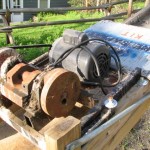
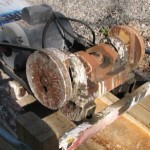
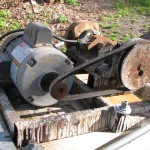
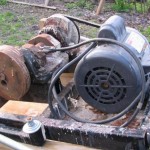
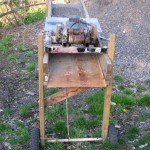
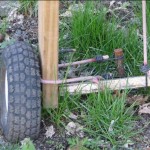
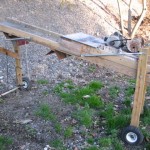
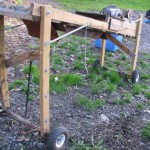
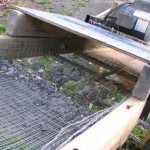
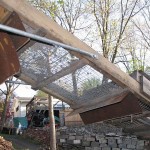
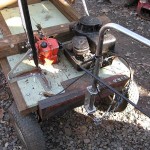
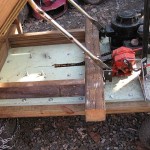
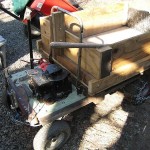
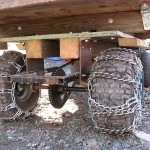
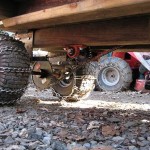
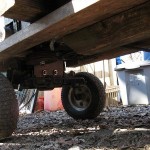
Thank you so much for this information. My Dad is going to be so happy to see all of this. I am hoping it will inspire him to start working again!
Power barrow, great device, but can you explain please? –
The B & S motor is vertical shaft, how does this connect with the (is it?) red gearbox (thought it was a chainsaw motor at first) and then it seems that the red gearbox device drives the rear wheels by chain.
Thanks in advance.
Paul
The red riding mower forward/reverse transmission has its input shaft vertical underneath, the output shaft is horizontal, so the vertical shaft mower engine drives it by belt. There is a belt tightening back-bend idler pulley underneath that acts as the clutch, with some screws driven into the plywood chassis to act as belt guides, so it can’t fall off when disengaged and loose.
The transmission input shaft drives a small bevel gear that drives two larger bevel gears in opposite directions and floating on the output shaft. A sliding dog clutch keyed to the output shaft is moved to engage either of the large bevel gears, giving the forward or reverse drive.
Ken, this is great stuff. I was looking for a DIY trommel setup, saw yours, and then made it over here to the screener. I have about 30 to 40 yards of dirt I am excavating (by hand) from under my porch and it is full of rocks (FULL). So, your solution is right up my alley. I have some big pieces of clay as well…no idea what to do with them as they are pretty saturated. I guess I can wait for them to dry out and then hit them with a hand tamper or something. I would love to hear your thoughts on the clay or any current additions you may have made to the screener.
Thanks
Jason
HI JASON,
THERE’S THREE CHOICES FOR WET CLAY. MAKE SOME POTTERY, LET IT DRY AND SMASH IT, AND I FORGOT THE THIRD ONE. I REMEMBER, BACK DURING WWII, WHEN AUTO BODY REPAIR STEEL WAS NOT AVAILABLE, A FRIEND IN RED BANK, NJ STAYED IN BUSINESS BY PACKING RUST HOLES IN CARS WITH RED CLAY FROM THE RIVER BANK AND BAKING IT WITH A BLOWTORCH, FILING, SANDING AND PAINTING IT.
THE BOUNCING SHAKER WAS THE SIMPLEST MACHINE I COULD MAKE, THE 4 WHEELS CAME FROM TRACTOR SUPPLY, ON SALE AT $5 EACH. THE AXLES ARE 5/8 INCH DIAMETER READY-ROD. THE OSCILLATOR, WITH ITS NEW 3/4 HP MOTOR CAME FROM A JUNKED 5 GALLON PAIL PAINT SHAKER, PROBABLY NOT AN EASY ITEM TO FIND. YOU REALLY WANT ABOUT 15 POUNDS OF OFF-CENTER WEIGHT RUNNING ABOUT 1/3 MOTOR SPEED, ABOUT 600 RPM. YOU DON’T REALLY NEED 3/4 HP, 1/2 SHOULD BE OK.
NOT SHOWN IN THE VIDEO IS THAT I PUT COVERING BOARDS ABOVE THE SCREENS TO KEEP THE ROCKS FROM BEING THROWN ALL OVER.
IF I HAD TO BUILD A NEWER MACHINE WITH MOSTLY FOUND ITEMS, I WOULD PROBABLY HAVE TO FIND SOME OTHER WAY TO MAKE IT SHAKE. ONE THOUGHT IS TO GET THE MOTOR OUT OF A JUNK CLOTHES DRYER, TRY TO GET ONE ON FREECYCLE (WWW.FREECYCLE.COM). DRYER MOTORS HAVE A SHAFT AT EACH END, ONE TO DRIVE THE DRUM, THE OTHER TO DRIVE THE BLOWER. FOR ECCENTRIC WEIGHTS, I WOULD CONSIDER BUYING A COUPLE OF STEEL OR CAST IRON PULLEYS, CUT AWAY ONE HALF AND MOUNTING THEM ON THE MOTOR SHAFTS. THIS WILL GIVE HIGHER VIBRATING SPEED WITH LESS AMPLITUDE, BUT SHOULD BE OK.
THE VIBRATION WOULD BE HARD ON THE MOTOR BEARINGS, FREECYCLE JUNK DRYERS ARE NOT IN SHORT SUPPLY.
IT’S REALLY IMPORTANT TO BUILD THE MACHINE TALL ENOUGH TO GET ONE OR MORE WHEELBARROWS OR GARDEN TRAILERS UNDERNEATH, LETTING THE SIFTED MATERIAL JUST FALL ON THE GROUND MEANS YOU HAVE TO SHOVEL IT AGAIN, TOO MUCH EXTRA WORK.
IF YOU CAN’T GET THE SCREENER CLOSE ENOUGH TO WHERE YOU ARE DIGGING, MAKE A WOODEN CHUTE WITH A VIBRATOR TO TOSS THE DIRT ON AND CARRY IT TO THE SCREENER, EVEN IF IT FALLS TO THE GROUND AND YOU HAVE TO SHOVEL IT INTO THE SCREENER, IT WILL BE LESS WORK THAN WALKING BACK AND FORTH, ONE SHOVEL AT A TIME.
I’LL BE INTERESTED IN WHAT YOU END UP BUILDING.
nice design! I am putting together a PDF of my own design (lower tec– our goal was to make a system better than what we had and without a motor) for the USCC, but would like to at least put links of other designs at the end.
may I site you and your design?
http://www.facebook.com/video/video.php?v=4059742814969
Very nice! However, I’d recommend running it in reverse and situating the operator behind the load for safety’s sake. Not that hard to change it around, I’d think. Terrific idea, thanks for getting my thoughts in gear!
Natasha, that’s a great video! Yes, please do site Nifty-Stuff.com on the design.
HI NATASHA,
I LIKE YOUR ROCKER MOTION FOR A MANUALLY OPERATED SCREEN, WOULD YOU CONSIDER MAKING IT TO ROCK FAR ENOUGH FOR THE MATERIAL TO SLIDE A BIT. YOU WOULDN’T HAVE TO ROCK IT AS FAST AND WOULD NOT NEED THE KNOCKING TO AGITATE THE MATERIAL. THE SLIDING WOULD NOT LET THE MATERIAL BUNCH UP IN THE CENTER.
THE AMOUNT OF WORK, EXPENDED ENERGY NECESSARY WOULD PROBABLY BE LESS.
A GAS POWERED MOTORIZED CONVERSION USING A SMALL ENGINE WITH THE BUILT-IN 6 TO 1 REDUCTION DRIVING A CRANK THROW ON THE OUTPUT SHAFT WITH A CONNECTING ROD TO THE ROCKER WOULD BE INTERESTING.
DENNIS, THE POWERED WHEELBARROW RUNS THE SAME FORWARD OR REVERSE, AND WAS BUILT THAT WAY. I ACTUALLY DON’T KNOW WHICH END IS THE FRONT, BUT IF THE STEERING WHEELS ARE AT THE REAR, YOU HAVE TO BE ON YOUR TOES AT ALL TIMES BECAUSE IT CAN JACK-KNIFE IN A FRACTION OF A SECOND IF A WHEEL HITS AN OBSTRUCTION, LIKE A ROCK OR A DIP OR HUMMOCK. ON ROUGH GROUND I PREFER TO LEAD THE MACHINE RATHER THAN FOLLOW IT, ESPECIALLY AT ITS MAXIMUM (WALKING) SPEED. IF FOLLOW IT, I RUN AT A SLOWER SPEED TO GIVE ME MORE REACTION TIME.
ACTUALLY, THE STEERING RATIO, LEVERAGE, SHOULD BE BETTER, SO THE STEERING WHEELS CAN’T BE KNOCKED ABOUT SO EASILY ON ROUGH GROUND. THE CURRENT SETUP S A BIT PRIMITIVE, BUT IT WORKS.
REGARDS,
KEN
Suggest possible addition of a pivoted right angle extension on the steering handle so you can walk beside the barrow. Sort of like on a small sail boat tiller handle.
Gene, a side mounted tiller, actually one on each side is a good idea, one which i considered. what stopped me was having to maneuver through narrow openings, and in the woods on my daughter’s property. I didn’t want anything that might stick out the side that might snag on something or limit my steering. I could use a longer tiller handle to get further away when leading the machine, again limited in its swing angle so it doesn’t swing past the sides of the machine. if it didn’t get in the way of the dump box, I’d like a tiller on the other end.
In it’s fifth year, it still gets lots of use.
you could also try to find an old gas lawn mower engine and cut open the crank case. attach a v pulley to the crank shaft at the blade end and attach it to a 1/4 horse electric motor with a v belt. Mount the engine block to a frame and attach the piston end of the connecting rod to your shaker board.
for a rocking screener, the use of an old engine sounds like it might work.
The main bearing(s) and connecting rod all need lots of lubrication, so I would consider not cutting the crankcase open. Instead, I might prefer to screw one tie-rod end to the top of the piston, and attach the other end of the tie-rod to the moving part. I would probably run the machine relatively slowly, if using a tilted rocker screen mechanism, with enough aangle so the material could slide back and forth (left and right) on the screen as the pieces too big to fall through the screen slides down and off the end.a long rocker with increasingly larger openings toward the discharge end so you could get more than one size of screened material, from potting soil to pebbles, to larger material.